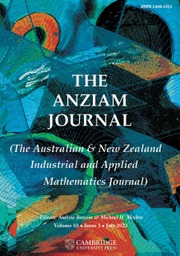No CrossRef data available.
Article contents
WATER WAVE SCATTERING BY  $\large \boldsymbol {\sqcap }$-SHAPED AND INVERTED
$\large \boldsymbol {\sqcap }$-SHAPED AND INVERTED  $\large \boldsymbol {\sqcap }$-SHAPED POROUS BREAKWATERS
$\large \boldsymbol {\sqcap }$-SHAPED POROUS BREAKWATERS
Published online by Cambridge University Press: 05 September 2025
Abstract
A semi-analytical study of oblique wave interaction with two  $\boldsymbol {\sqcap }$-shaped breakwater designs—floating and bottom-fixed structures—incorporating two thin porous plates is presented using linearized theory. Wave potential for both configurations is developed using the eigenfunction expansion method, considering both progressive and evanescent wave modes. The problem of oblique wave scattering by
$\boldsymbol {\sqcap }$-shaped breakwater designs—floating and bottom-fixed structures—incorporating two thin porous plates is presented using linearized theory. Wave potential for both configurations is developed using the eigenfunction expansion method, considering both progressive and evanescent wave modes. The problem of oblique wave scattering by  $\boldsymbol {\sqcap }$-shaped breakwaters is reduced to a set of coupled integral equations of first kind, based on horizontal velocity components. These equations are solved using the multi-term Galerkin approximation with appropriate basis functions to handle the square-root singularities at sharp edges of the porous barriers. The performance of the models is evaluated by examining reflection, transmission and energy dissipation coefficients, along with free surface elevation and horizontal drift force. We observe that increasing the plate length of the breakwaters attenuates the incident waves more effectively than increasing the width. Additionally, the floating
$\boldsymbol {\sqcap }$-shaped breakwaters is reduced to a set of coupled integral equations of first kind, based on horizontal velocity components. These equations are solved using the multi-term Galerkin approximation with appropriate basis functions to handle the square-root singularities at sharp edges of the porous barriers. The performance of the models is evaluated by examining reflection, transmission and energy dissipation coefficients, along with free surface elevation and horizontal drift force. We observe that increasing the plate length of the breakwaters attenuates the incident waves more effectively than increasing the width. Additionally, the floating  $\boldsymbol {\sqcap }$-shaped breakwater significantly reduces the free surface elevation in the transmitted region. The results from the developed model can provide valuable insights for the design of wave–structure systems in shallow waters.
$\boldsymbol {\sqcap }$-shaped breakwater significantly reduces the free surface elevation in the transmitted region. The results from the developed model can provide valuable insights for the design of wave–structure systems in shallow waters.
Keywords
Information
- Type
- Research Article
- Information
- Copyright
- © The Author(s), 2025. Published by Cambridge University Press on behalf of the Australian Mathematical Publishing Association Inc.


